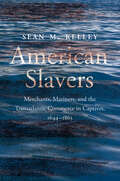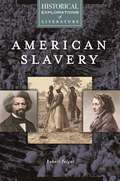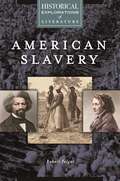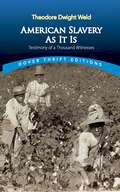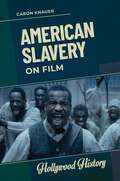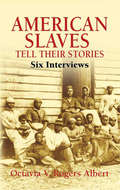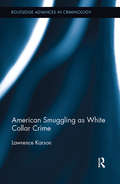- Table View
- List View
American Rural Communities
by A. E. LuloffThis book is dedicated to the people of rural America whose struggle to make community meaningful provides important lessons. It includes the contributors' prescription for the 1990s that calls for a renewal of action, development, and leadership on the part of local citizens and civic leaders.
American Rural Communities
by A. E. Luloff Louis E. SwansonThis book is dedicated to the people of rural America whose struggle to make community meaningful provides important lessons. It includes the contributors' prescription for the 1990s that calls for a renewal of action, development, and leadership on the part of local citizens and civic leaders.
American Scary: A History of Horror, from Salem to Stephen King and Beyond
by Jeremy Dauber"America is the world's biggest haunted house and American Scary is the only travel guide you need. I loved this book." —Grady Hendrix, New York Times bestselling author of How to Sell a Haunted House and The Final Girl Support GroupFrom the acclaimed author of American Comics comes a sweeping and entertaining narrative that details the rise and enduring grip of horror in American literature, and, ultimately, culture—from the taut, terrifying stories of Edgar Allan Poe to the grisly, lingering films of Jordan Peele America is held captive by horror stories. They flicker on the screen of a darkened movie theater and are shared around the campfire. They blare out in tabloid true-crime headlines, and in the worried voices of local news anchors. They are consumed, virally, on the phones in our pockets. Like the victims in any slasher movie worth its salt, we can&’t escape the thrall of scary stories. In American Scary, noted cultural historian and Columbia professor Jeremy Dauber takes the reader to the startling origins of horror in the United States. Dauber draws a captivating through line that ties historical influences ranging from the Salem witch trials and enslaved-person narratives directly to the body of work we more closely associate with horror today: the weird tales of H. P. Lovecraft, the lingering fiction of Shirley Jackson, the disquieting films of Alfred Hitchcock, the up-all-night stories of Stephen King, and the gripping critiques of Jordan Peele. With the dexterous weave of insight and style that have made him one of America&’s leading historians of popular culture, Dauber makes the haunting case that horror reveals the true depths of the American mind.
American Science Fiction and the Cold War: Literature and Film
by David SeedFirst Published in 1999. Routledge is an imprint of Taylor & Francis, an informa company.
American Science Fiction and the Cold War: Literature and Film (America In The 20th/21st Century Ser. #Vol. 3)
by David SeedFirst Published in 1999. Routledge is an imprint of Taylor & Francis, an informa company.
American Science Fiction TV: Star Trek, Stargate and Beyond (Popular Television Genres)
by Jan Johnson-SmithFrom "The Next Generation" and "The X-Files", to "Farscape" and "Enterprise", sci-fi television series in the US have multiplied since the 1980s. Jan Johnson-Smith shows how, in line with national political upheavals, this vibrant and perplexing genre set about expanding the myth of the Western frontier into deep space. She looks at the "sense of wonder" or sublime that infuses much Frontier art and science fiction, and traces a possible historical precedent to the genre in the fabulous and heroic journeys of the Classical epic. She discusses narrative styles and their influences, from the overarching narrative of "Babylon 5" to the episodic formula of "The Outer Limits", considers how experimental series such as "Twin Peaks" challenge conventional structures, and how and why sci-fi television has adopted new technologies. She also explores the juxtaposition of arcane language and technological jargon in modern American sci-fi television, revealing the extraordinarily alien, yet curiously familiar arena it creates.
American Sea Literature: Seascapes, Beach Narratives, And Underwater Explorations
by S. YamashiroImplementing a never-before-seen approach to sea literature, American Sea Literature: Seascapes, Beach Narratives, and Underwater Explorations explores the role of American maritime activities and their cultural representations in literature. Differentiating between the 'terrestrial' and 'oceanic' as concepts, Shin Yamashiro divides sea literature into three categories: literature on the sea, by the sea, and beneath the sea. Discussing both canonical works and new books on scuba diving, deep-sea explorations, and surfing, this fascinating study recognizes sea literature's unique influence on American history.
American Settler Colonialism: A History
by W. HixsonOver the course of three centuries, American settlers helped to create the richest, most powerful nation in human history, even as they killed and displaced millions. This groundbreaking work shows that American history is defined by settler colonialism, providing a compelling framework through which to understand its rise to global dominance.
American Shtetl: The Making of Kiryas Joel, a Hasidic Village in Upstate New York
by Nomi M. Stolzenberg David N. MyersA compelling account of how a group of Hasidic Jews established its own local government on American soilSettled in the mid-1970s by a small contingent of Hasidic families, Kiryas Joel is an American town with few parallels in Jewish history—but many precedents among religious communities in the United States. This book tells the story of how this group of pious, Yiddish-speaking Jews has grown to become a thriving insular enclave and a powerful local government in upstate New York. While rejecting the norms of mainstream American society, Kiryas Joel has been stunningly successful in creating a world apart by using the very instruments of secular political and legal power that it disavows.Nomi Stolzenberg and David Myers paint a richly textured portrait of daily life in Kiryas Joel, exploring the community's guiding religious, social, and economic norms. They delve into the roots of Satmar Hasidism and its charismatic founder, Rebbe Joel Teitelbaum, following his journey from nineteenth-century Hungary to post–World War II Brooklyn, where he dreamed of founding an ideal Jewish town modeled on the shtetls of eastern Europe. Stolzenberg and Myers chart the rise of Kiryas Joel as an official municipality with its own elected local government. They show how constant legal and political battles defined and even bolstered the community, whose very success has coincided with the rise of political conservatism and multiculturalism in American society over the past forty years.Timely and accessible, American Shtetl unravels the strands of cultural and legal conflict that gave rise to one of the most vibrant religious communities in America, and reveals a way of life shaped by both self-segregation and unwitting assimilation.
American Sirens: The Incredible Story of the Black Men Who Became America's First Paramedics
by Kevin HazzardThe extraordinary story of an unjustly forgotten group of Black men in Pittsburgh who became the first paramedics in America, saving lives and changing the course of emergency medicine around the world Until the 1970s, if you suffered a medical crisis, your chances of survival were minimal. A 9-1-1 call might bring police or even the local funeral home. But that all changed with Freedom House EMS in Pittsburgh, a group of Black men who became America&’s first paramedics and set the gold standard for emergency medicine around the world, only to have their story and their legacy erased—until now.In American Sirens, acclaimed journalist and paramedic Kevin Hazzard tells the dramatic story of how a group of young, undereducated Black men forged a new frontier of healthcare. He follows a rich cast of characters that includes John Moon, an orphan who found his calling as a paramedic; Peter Safar, the Nobel Prize-nominated physician who invented CPR and realized his vision for a trained ambulance service; and Nancy Caroline, the idealistic young doctor who turned a scrappy team into an international leader. At every turn, Freedom House battled racism—from the community, the police, and the government. Their job was grueling, the rules made up as they went along, their mandate nearly impossible—and yet despite the long odds and fierce opposition, they succeeded spectacularly. Never-before revealed in full, this is a rich and troubling hidden history of the Black origins of America&’s paramedics, a special band of dedicated essential workers, who stand ready to serve day and night on the line between life and death for every one of us.
American Skinheads: The Criminology and Control of Hate Crime
by Mark S. HammAmerican Skinheads is the first criminological analysis of organized hate crime violence. Mark Hamm presents historical specificity for a modern theory of hate crime, then rigorously tests the theory with interview data derived from skinheads who have committed an array of violent acts against persons because of their race, religion, or sexual preference--people who are members of the classic outgroups of American society.Part One traces the roots of the Skinhead Nation through the Beats, Mods, Hippies, and Punks in London, and then examines the rise of the Neo-Nazi Skinheads in the United States, including a look at Neo-Nazi offshoots (Romantic Violence, The Aryan Youth Movement), recruiters (Tom Metzger), and recruitment tools (W.A.R. Magazine and Hotline, electronic mail, Race and Reason), and appearances on the Oprah Winfrey and Geraldo Rivera shows. In Part Two, Hamm discusses the accepted sociological perspectives on terrorist youth subcultures (not gangs), then presents findings of his own study of 36 skinheads, including social and economic characteristics, psychological profiles, the role of skinhead girls, use of drugs and weapons, satanism, and neo-fascism. Part Three assesses the future for American Neo-Nazism and recommends steps for preventing skinhead terrorism.
American Slave Revolts and Conspiracies: A Reference Guide
by Professor Kerry WaltersProvides a comprehensive overview of 10 major slave revolts and examines how those uprisings and conspiracies impacted slaveholding colonies and states from 1663 to 1861.Hundreds of slave revolts and conspiracies occurred during the two centuries that North America engaged in slavery. None were successful, but certain campaigns were significant enough to inspire other revolts, fuel a chronic fear of uprising in slaveholders and politicians, and keep alive the perennial desire for freedom felt by black slaves. Kerry Walters examines 10 representative revolts and offers narratives, primary materials, chronologies and biographies of participants for high school and undergraduate students.The book also contains an annotated bibliography of print and online primary and secondary sources for students seeking material for research papers and projects, as well as an examination of fictional depictions of slave revolts in novels and film. Walters offers information on a compelling topic that will be of interest to students of American history or sociology as well as anyone engaging in multicultural studies.
American Slave Revolts and Conspiracies: A Reference Guide
by Professor Kerry WaltersProvides a comprehensive overview of 10 major slave revolts and examines how those uprisings and conspiracies impacted slaveholding colonies and states from 1663 to 1861.Hundreds of slave revolts and conspiracies occurred during the two centuries that North America engaged in slavery. None were successful, but certain campaigns were significant enough to inspire other revolts, fuel a chronic fear of uprising in slaveholders and politicians, and keep alive the perennial desire for freedom felt by black slaves. Kerry Walters examines 10 representative revolts and offers narratives, primary materials, chronologies and biographies of participants for high school and undergraduate students.The book also contains an annotated bibliography of print and online primary and secondary sources for students seeking material for research papers and projects, as well as an examination of fictional depictions of slave revolts in novels and film. Walters offers information on a compelling topic that will be of interest to students of American history or sociology as well as anyone engaging in multicultural studies.
American Slavers: Merchants, Mariners, and the Transatlantic Commerce in Captives, 1644-1865
by Sean M. KelleyThe first telling of the unknown story of America’s two-hundred-year history as a slave-trading nation A total of 305,000 enslaved Africans arrived in the New World aboard American vessels over a span of two hundred years as American merchants and mariners sailed to Africa and to the Caribbean to acquire and sell captives. Using exhaustive archival research, including many collections that have never been used before, historian Sean M. Kelley argues that slave trading needs to be seen as integral to the larger story of American slavery. Engaging with both African and American history and addressing the trade over time, Kelley examines the experience of captivity, drawing on more than a hundred African narratives to offer a portrait of enslavement in the regions of Africa frequented by American ships. Kelley also provides a social history of the two American ports where slave trading was most intensive, Newport and Bristol, Rhode Island. In telling this tragic, brutal, and largely unknown story, Kelley corrects many misconceptions while leaving no doubt that Americans were a nation of slave traders.
American Slavery: A Historical Exploration of Literature (Historical Explorations of Literature)
by Robert FelgarUtilizing key selections from American literature, this volume aligns with ELA Common Core Standards to give students a fresh perspective on and a keener understanding of slavery in the United States.Slavery is a central feature of American history, one with which the nation still has not come fully to terms. In this book, that seminal topic is examined in a fresh way—through literature. Organized chronologically to show evolving attitudes toward American slavery in the 19th century, the work focuses on four key 19th-century texts that are frequently taught, using them as a gateway for understanding this critical period and why slavery had to be destroyed if the Union was to be maintained.In addition to examining the four works—Frederick Douglass's Narrative of the Life of Frederick Douglass, Harriet Beecher Stowe's Uncle Tom's Cabin, Harriet Jacobs's Incidents in the Life of a Slave Girl, and Mark Twain's Huckleberry Finn—the book also provides numerous historical documents that contextualize slavery in the literary texts. These documents make it dramatically clear why issues such as abolition and the Fugitive Slave Law of 1850 were so controversial for 19th-century Americans. Aligned with the ELA Common Core Standards, the title supports history teachers with insights into classic literary works, and it enhances the English curriculum with rich elaborations of relevant historical context.
American Slavery: A Historical Exploration of Literature (Historical Explorations of Literature)
by Robert FelgarUtilizing key selections from American literature, this volume aligns with ELA Common Core Standards to give students a fresh perspective on and a keener understanding of slavery in the United States.Slavery is a central feature of American history, one with which the nation still has not come fully to terms. In this book, that seminal topic is examined in a fresh way—through literature. Organized chronologically to show evolving attitudes toward American slavery in the 19th century, the work focuses on four key 19th-century texts that are frequently taught, using them as a gateway for understanding this critical period and why slavery had to be destroyed if the Union was to be maintained.In addition to examining the four works—Frederick Douglass's Narrative of the Life of Frederick Douglass, Harriet Beecher Stowe's Uncle Tom's Cabin, Harriet Jacobs's Incidents in the Life of a Slave Girl, and Mark Twain's Huckleberry Finn—the book also provides numerous historical documents that contextualize slavery in the literary texts. These documents make it dramatically clear why issues such as abolition and the Fugitive Slave Law of 1850 were so controversial for 19th-century Americans. Aligned with the ELA Common Core Standards, the title supports history teachers with insights into classic literary works, and it enhances the English curriculum with rich elaborations of relevant historical context.
American Slavery: History In An Hour (The\history In An Hour Ser.)
by Kat SmutzLove history? Know your stuff with History in an Hour.
American Slavery and Russian Serfdom in the Post-Emancipation Imagination
by Amanda Brickell BellowsThe abolition of Russian serfdom in 1861 and American slavery in 1865 transformed both nations as Russian peasants and African Americans gained new rights as subjects and citizens. During the second half of the long nineteenth century, Americans and Russians responded to these societal transformations through a fascinating array of new cultural productions. Analyzing portrayals of African Americans and Russian serfs in oil paintings, advertisements, fiction, poetry, and ephemera housed in American and Russian archives, Amanda Brickell Bellows argues that these widely circulated depictions shaped collective memory of slavery and serfdom, affected the development of national consciousness, and influenced public opinion as peasants and freedpeople strove to exercise their newfound rights. While acknowledging the core differences between chattel slavery and serfdom, as well as the distinctions between each nation's post-emancipation era, Bellows highlights striking similarities between representations of slaves and serfs that were produced by elites in both nations as they sought to uphold a patriarchal vision of society. Russian peasants and African American freedpeople countered simplistic, paternalistic, and racist depictions by producing dignified self-representations of their traditions, communities, and accomplishments. This book provides an important reconsideration of post-emancipation assimilation, race, class, and political power.
American Slavery As It Is: Selections from the Testimony of a Thousand Witnesses (Dover Thrift Editions)
by Theodore Dwight WeldThe stories of hundreds of African-Americans who lived in bondage are preserved in this powerful 1839 chronicle. Compiled by a prominent abolitionist, the accounts include personal narratives from freed slaves as well as testimonials from active and former slave owners, presenting a condemnation of slavery from both those who experienced it and those who perpetuated it. Detailing the overall conditions of slaves across multiple states and several years, the book includes information on their diet, clothing, housing, and working hours as well as their punishments and suffering.Connecticut farmer-turned-abolitionist Theodore Dwight Weld (1803–1895) was a central leader of the American Anti-Slavery Society and traveled the country lecturing against slavery. Weld took great pains to document the trustworthiness of contributors to American Slavery so that there could be no doubt as to its authenticity. A major influence on Harriet Beecher Stowe's Uncle Tom's Cabin, the book sold 100,000 copies in its first year of publication and remains a valuable historical testament. This edited selection presents these powerful first-person accounts to a new generation.
American Slavery on Film (Hollywood History)
by Caron KnauerA comprehensive and timely resource on the depictions in film of enslaved African Americans and slavery from the Antebellum Period to Emancipation.American Slavery on Film highlights historical and contemporary depictions in film of the resistance, rebellion, and resilience of enslaved African Americans in the United States from the Antebellum period to Emancipation. In her study of such films as Uncle Tom's Cabin (1914), a silent movie adaptation of Harriet Beecher Stowe's novel; the groundbreaking and successful television miniseries Roots (1977); and the Harriet Tubman biopic Harriet (2019), Caron Knauer analyzes how African American slavery has been and continues to be portrayed in major studio blockbusters and independent films alike. Separating the romanticized and unrealistic depictions of slavery from the more accurate but often unflinching portrayals of its horrors, the author covers a wide range of topics, including the impact of slavery on popular culture, the Underground Railroad, Maroon communities, and the Los Angeles Film Rebellion of the 1960s. As a result, this book delivers a comprehensive, readable, and timely examination of enslaved African Americans and slavery in America's film history.
American Slavery on Film (Hollywood History)
by Caron KnauerA comprehensive and timely resource on the depictions in film of enslaved African Americans and slavery from the Antebellum Period to Emancipation.American Slavery on Film highlights historical and contemporary depictions in film of the resistance, rebellion, and resilience of enslaved African Americans in the United States from the Antebellum period to Emancipation. In her study of such films as Uncle Tom's Cabin (1914), a silent movie adaptation of Harriet Beecher Stowe's novel; the groundbreaking and successful television miniseries Roots (1977); and the Harriet Tubman biopic Harriet (2019), Caron Knauer analyzes how African American slavery has been and continues to be portrayed in major studio blockbusters and independent films alike. Separating the romanticized and unrealistic depictions of slavery from the more accurate but often unflinching portrayals of its horrors, the author covers a wide range of topics, including the impact of slavery on popular culture, the Underground Railroad, Maroon communities, and the Los Angeles Film Rebellion of the 1960s. As a result, this book delivers a comprehensive, readable, and timely examination of enslaved African Americans and slavery in America's film history.
American Slaves Tell Their Stories: Six Interviews (African American)
by Octavia V. AlbertVivid narratives recall life during and just after the Civil War, not only describing cruel punishments, divided families, and debilitating labor, but also providing information about religious beliefs and practices, as well as the condition and progress of former slaves. Essential reading for students of African-American studies.
American Smuggling as White Collar Crime (Routledge Advances in Criminology #17)
by Lawrence KarsonWhen Edwin Sutherland introduced the concept of white-collar crime, he referred to the respectable businessmen of his day who had, in the course of their occupations, violated the law whenever it was advantageous to do so. Yet since the founding of the American Republic, numerous otherwise respectable individuals had been involved in white-collar criminality. Using organized smuggling as an exemplar, this narrative history of American smuggling establishes that white-collar crime has always been an integral part of American history when conditions were favorable to violating the law. This dark side of the American Dream originally exposed itself in colonial times with elite merchants of communities such as Boston trafficking contraband into the colonies. It again came to the forefront during the Embargo of 1809 and continued through the War of 1812, the Civil War, nineteenth century filibustering, the Mexican Revolution and Prohibition. The author also shows that the years of illegal opium trade with China by American merchants served as precursor to the later smuggling of opium into the United States. The author confirms that each period of smuggling was a link in the continuing chain of white-collar crime in the 150 years prior to Sutherland’s assertion of corporate criminality.
American Smuggling as White Collar Crime (Routledge Advances in Criminology)
by Lawrence KarsonWhen Edwin Sutherland introduced the concept of white-collar crime, he referred to the respectable businessmen of his day who had, in the course of their occupations, violated the law whenever it was advantageous to do so. Yet since the founding of the American Republic, numerous otherwise respectable individuals had been involved in white-collar criminality. Using organized smuggling as an exemplar, this narrative history of American smuggling establishes that white-collar crime has always been an integral part of American history when conditions were favorable to violating the law. This dark side of the American Dream originally exposed itself in colonial times with elite merchants of communities such as Boston trafficking contraband into the colonies. It again came to the forefront during the Embargo of 1809 and continued through the War of 1812, the Civil War, nineteenth century filibustering, the Mexican Revolution and Prohibition. The author also shows that the years of illegal opium trade with China by American merchants served as precursor to the later smuggling of opium into the United States. The author confirms that each period of smuggling was a link in the continuing chain of white-collar crime in the 150 years prior to Sutherland’s assertion of corporate criminality.
American Smuggling as White Collar Crime (Routledge Advances in Sociology)
by Lawrence KarsonWhen Edwin Sutherland introduced the concept of white-collar crime, he referred to the respectable businessmen of his day who had, in the course of their occupations, violated the law whenever it was advantageous to do so. Yet since the founding of the American Republic, numerous otherwise respectable individuals had been involved in white-collar criminality. Using organized smuggling as an exemplar, this narrative history of American smuggling establishes that white-collar crime has always been an integral part of American history when conditions were favorable to violating the law.This dark side of the American Dream originally exposed itself in colonial times with elite merchants of communities such as Boston trafficking contraband into the colonies. It again came to the forefront during the Embargo of 1809 and continued through the War of 1812, the Civil War, nineteenth century filibustering, the Mexican Revolution and Prohibition. The author also shows that the years of illegal opium trade with China by American merchants served as precursor to the later smuggling of opium into the United States. The author confirms that each period of smuggling was a link in the continuing chain of white-collar crime in the 150 years prior to Sutherland’s assertion of corporate criminality.











